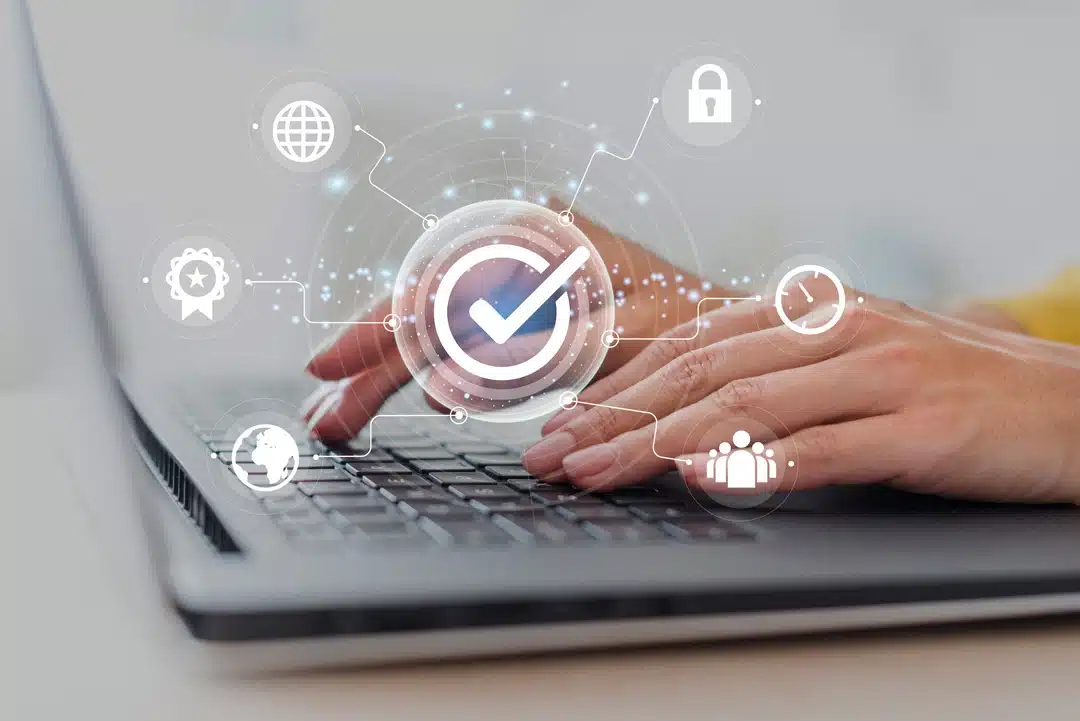Table of Contents
Cyber threats loom large. So, when it comes to developing software applications, one word should ring louder than any other: security.
Ever wonder why some software applications are hacked while others remain unscathed? The answer, more often than not, revolves around the SDLC and how security is woven into it. A proper SSDLC can make the difference between a trusted application and one that becomes a hacker’s playground. In this comprehensive article, we delve into why security is crucial in the SDLC and how it plays out in each SDLC phase.
What is the Secure Software Development Life Cycle (SSDLC)?
The Secure Software Development Life Cycle, or SSDLC, is an agile development cycle approach that incorporates security principles right from the inception of a software project to its deployment and beyond. Unlike many other traditional approaches where security is often tacked on near the end or during post-production, it’s a systematic approach that involves identifying potential risks, incorporating secure coding practices, performing security testing, and ongoing monitoring. This all helps to ensure the development of secure, reliable applications.
The Importance of Security in the SDLC
Building security into the SDLC from the outset helps organizations identify and address potential security issues earlier, saving time, effort, and resources in the long run. It’s much like constructing a house – the earlier you consider safety measures, the better. Rather than retrofitting security measures after a breach, a proactive approach mitigates the risk before it becomes a problem. This not only leads to more robust software but also reduces the cost of addressing security incidents, which can be exorbitant if not dealt with timely and effectively. In fact, a recent 2022 report from IBM suggests that the average cost of a data breach is $4.35 million.

Overview of the SDLC Phases and Security Considerations in Each SDLC Phase
So, without further ado, Let’s kick off this security-centered journey through the SDLC by exploring each phase in detail.
Phase 1: Requirements Gathering
This initial phase sets the stage for the entire project. It’s all about defining the ‘what’ and ‘how’ of the software – what it needs to accomplish, and how it should operate.
Identifying security requirements
In the context of security, it’s crucial to identify the application’s specific security requirements during this phase. This might involve adhering to industry standards, compliance regulations, and organizational policies. For example, a healthcare application might require HIPAA compliance, ensuring patient data is strictly confidential and accessible only to authorized personnel. Security requirements might also include user authentication protocols, accessibility restrictions, privacy rules, and audibility. By documenting these requirements early, the team can design and develop a solution that addresses them from the outset, avoiding costly and time-consuming changes later on.
Conducting risk assessments
Risk assessments form the second pillar of this phase. These assessments are designed to uncover potential threats and vulnerabilities that could impact the software’s security. Techniques such as threat modeling help prioritize security efforts, making sure you’re not just putting up walls but strategically defending against potential threats. It’s all about understanding what could go wrong and how you can prevent it before you start writing the first line of code.
Requirements Gathering Checklist
- Define the purpose and scope of the software, incorporating a strong emphasis on security.
-
Identify and document all relevant security requirements, considering industry standards, compliance regulations, and organizational policies.
- Perform comprehensive risk assessments to identify potential threats and vulnerabilities.
- Prioritize security efforts based on potential impacts and the likelihood of threats.
- Ensure all stakeholders understand and agree on the security requirements and potential risks.
Phase 2: Architecture and Design
The Architecture and Design phase is akin to drawing up a detailed battle plan against potential cyber threats. By diligently defining the security architecture and controls, you set yourself up for success in the subsequent phases of the SDLC.
Incorporating security architecture
Security architecture is an integral part of this phase. It involves designing and embedding security controls and mechanisms into the overall system architecture to ensure that the software is secure from the ground up. Security architecture components like firewalls, intrusion detection systems (IDS), and secure network segmentation serve as protective layers to maintain the confidentiality, integrity, and availability of the software application.
Defining security controls
After laying down the architecture, this is where the necessary measures to protect the software based on the identified risks and security requirements are decided. A sound set of security controls might include access controls, encryption techniques, comprehensive logging practices, and secure coding principles. They function as your security toolkit, ready to combat any potential cyber threats that dare to breach your fortifications.
Architecture and Design Checklist
- Design a security architecture that integrates necessary security controls and mechanisms.
-
Ensure the architecture supports confidentiality, integrity, and availability of the software application.
- Identify appropriate security controls based on identified risks and security requirements.
- Consider utilizing access controls, encryption, logging, and secure coding practices as part of your security controls.
- Validate that the proposed architecture and controls align with the previously identified security requirements.
Phase 3: Implementation
This phase is all about getting hands-on. Here, the concepts and plans developed in the first two phases are transformed into tangible, secure code.
Secure coding practices and guidelines
Writing secure code is more than just avoiding bugs. It’s about ensuring that even when an attacker attempts to exploit your software, they’ll hit a brick wall. Key practices like input validation, output encoding, and proper error handling are integral to this approach.
Input validation helps ensure only correctly formatted data enters the system, while output encoding assures that output displayed to users is safe and free from harmful executable code. Handling errors efficiently maintains system stability and prevents exposure of sensitive information.
Several common vulnerabilities can also be mitigated by following secure coding practices. For instance, SQL injection, where an attacker manipulates an application to send harmful SQL commands to a database, can be prevented with proper input validation and the use of parameterized queries. Cross-site scripting (XSS), a vulnerability that allows attackers to inject malicious scripts into webpages viewed by other users, can be thwarted through output encoding. Buffer overflow vulnerabilities, where an application writes more data to a buffer than it can hold, can be mitigated by carefully validating input lengths and leveraging programming languages or compilers that offer automatic bounds checking.
Using guidelines and standards can help ensure consistent and secure coding practices. The OWASP Top 10 is a powerful tool, offering a list of the ten most critical web application security risks and providing guidance on how to mitigate them. Similarly, the CERT Secure Coding Standards offer guidelines for secure coding in various programming languages.
Input validation and data sanitization
Keeping a check on what comes into your software is as crucial as what leaves it. Input validation techniques such as whitelisting, blacklisting, and regular expressions, ensure that only legitimate inputs are allowed. Coupled with data sanitization practices, these techniques help prevent code injection attacks. It’s like a security check at the gate, only letting in the right people.
Access control mechanisms
Access controls serve as gatekeepers, ensuring that only authenticated and authorized users can access the software system. They form the basis for enforcing security at both a macro and micro level within the application. These controls comprise various techniques and mechanisms to manage user access, validating their identity and determining their permissions within the system.
One key technique is Role-Based Access Control (RBAC), where access rights are granted based on user roles within the organization. For instance, an HR manager would have different access rights compared to a software developer. This ensures that users only have access to the data and functionality required for their roles, preventing unauthorized access to sensitive information.
The principle of least privilege is another cornerstone of access control. It dictates that users should be granted the minimum permissions necessary to complete their tasks, reducing the risk of accidental or intentional misuse of privileged access.
Separation of duties, another technique, ensures that critical tasks or sensitive functionalities require more than one individual to execute. This reduces the risk of fraud or error, particularly in sensitive operations such as financial transactions.
Multi-factor authentication (MFA) is another great example of access control mechanisms where this adds an extra layer of security by combining something the user knows (e.g., a password), something they have (e.g., a token), and something they are (e.g., a fingerprint).
Password policies, such as enforcing complex passwords and regular password changes, further strengthen access control by making it harder for unauthorized users to guess user credentials. To simplify password management while maintaining security standards, organizations can implement enterprise password manager solutions that enable secure password storage, automated password rotation, and centralized policy enforcement across teams without compromising on individual credential security.
Implementation Checklist
- Implement secure coding practices, including input validation, output encoding, and error handling.
-
Adhere to secure coding guidelines and standards like the OWASP Top 10 and CERT Secure Coding Standards.
- Utilize input validation techniques and ensure data sanitization to prevent code injection attacks.
- Implement robust access control mechanisms, ensuring proper authentication and authorization.
- Implement strong password policies and enforce multi-factor authentication (MFA) wherever necessary.
Phase 4: Testing
Testing is essential for verifying and validating the security measures incorporated during the previous phases. It’s about ensuring that your software application is not only functionally sound but also resilient against potential security threats.
Security testing methodologies
There are a number of security testing methodologies that can be used to validate software application security, each one having its own pros and cons.
1. Static Analysis:
Static Analysis, also known as Static Application Security Testing (SAST), is a method of testing where the software code is analyzed without executing it. It involves inspecting the source code, byte code, or application binaries to identify potential vulnerabilities.
| Benefits: | Limitations: | |
|
|
|
|
|
2. Dynamic Analysis:
Dynamic Analysis, or Dynamic Application Security Testing (DAST), tests the application during its execution. It simulates attacks on a running application to identify security vulnerabilities that become apparent only during runtime.
| Benefits: | Limitations: | |
|
|
|
|
|
3. Manual Code Review:
Manual code review involves a human expert thoroughly examining the source code to identify security issues. It’s a meticulous process where the reviewer leverages their expertise and experience to identify vulnerabilities.
| Benefits: | Limitations: | |
|
|
|
|
|
Vulnerability scanning and penetration testing
Vulnerability scanning involves the use of automated tools to identify known vulnerabilities in the software application. It’s like a security health check, looking for symptoms of known security illnesses. Penetration testing takes this a step further and involves simulating real-world attacks to identify potential weaknesses. It provides a practical evaluation of the application’s defenses and its ability to withstand security threats.

Testing Checklist
- Apply the appropriate security testing methodology to test the security of the software application.
-
Use automated vulnerability scanning tools to identify known vulnerabilities.
- Conduct penetration testing to simulate real-world attacks and identify potential security weaknesses.
- Document all identified vulnerabilities, their potential impacts, and the necessary fixes.
- Ensure all identified vulnerabilities are addressed before moving to the next phase.
Phase 5: Deployment
At this stage, your software is just about ready to step into the real world. However, the application’s security should not be compromised during this transition.
Security testing methodologies
Securely configuring the application and its underlying infrastructure is a fundamental step to minimize potential security risks during the deployment phase of the SDLC. This involves establishing and implementing security parameters for different components of your software environment, including operating systems, databases, networks, and the application itself.
Secure configuration frameworks, like CIS Benchmarks, offer valuable guidance in this respect, and they are recognized as industry-standard best practices for securely configuring a system. These benchmarks provide well-defined guides that include a series of specific security configuration recommendations for various technology groups. Implementing these recommendations helps organizations to quickly set up an environment that aligns with globally recognized security standards, thereby ensuring the deployed software is robust against potential security threats.
Secure deployment practices
Ensuring the secure transmission of application files is a primary concern here. This process should prevent unauthorized access, ensuring that the application components are not tampered with during the transmission process. Furthermore, verifying the integrity of deployed components is essential to ensure that they have not been compromised. This involves checking the components against known secure versions or using digital signatures to ensure they remain unaltered.
Securing communication channels is another significant aspect of secure deployment. Encryption of data at rest is typically used to secure these channels, preventing eavesdropping or interception by malicious actors. HTTPS is a widely used protocol that provides such security, ensuring data confidentiality and integrity between the application and its users.
The use of secure deployment tools and techniques can greatly enhance application security. Secure containerization, for instance, encapsulates the application in a container with its own operating environment. This provides an additional layer of isolation, keeping the application and its environment secure. Another technique, code signing, ensures the authenticity and integrity of the code being deployed. It involves attaching a digital signature to the code. This signature verifies that the code has not been altered since it was signed, ensuring that only verified, trusted code is deployed.
Deployment Checklist
- Ensure environmental variables are not in source code and match their location. Possible solutions include storing in a Key Vault (Azure), in Secret Key (AWS) with encryption, or in System Parameter Store (AWS).
-
Use secure configuration frameworks like CIS Benchmarks to guide configuration management.
- Safely transmit application files using secure deployment techniques.
- Verify the integrity of the deployed components to ensure they have not been tampered with.
- Secure communication channels to prevent unauthorized access and data breaches during and post-deployment.
Phase 6: Maintenance and Support
Even after a successful deployment, your software needs continuous nurturing. Like a plant, it needs care, attention, and sometimes, corrective measures for it to grow and stay healthy.
Patch management
New vulnerabilities can surface at any time, even after your software is live. That’s why patch management is essential. It is the process of deploying updates or ‘patches’ to the software application. These updates often contain fixes to identified bugs or vulnerabilities. Ensuring these patches are promptly applied is vital as outdated software can provide an easy entry point for attackers. A streamlined patch management process aids in keeping your software secure and up to date.
Incident response and monitoring
In the unfortunate event of a security incident, it’s critical to have an incident response plan in place. This allows you to react quickly and effectively to minimize the damage. Also, continuous monitoring of your application can help detect any potential security incidents early. This includes logging, log analysis, and the use of intrusion detection systems (IDS) to spot any unusual activity that could indicate a security breach.
To put this into a more tangible context, consider a cloud-based application hosted on Amazon Web Services (AWS). One way to enhance monitoring is to set up AWS CloudTrail, a service that enables governance, compliance, operational auditing, and risk auditing of your AWS account.
CloudTrail provides event history of your AWS account activity, including actions taken through the AWS Management Console, AWS SDKs, command line tools, and other AWS services. This event history simplifies security analysis, resource change tracking, and troubleshooting. It essentially logs who did what, when, and from where. It can prove to be invaluable during incident response, providing a clear audit trail to help you understand the nature of the incident and aid in the response.
Maintenance and Support Checklist
- Establish a regular patch management process to address known vulnerabilities.
-
Use vulnerability management tools and processes to monitor and manage software vulnerabilities.
- Set up an incident response plan to respond to security incidents quickly and effectively.
- Implement strong logging and log analysis practices.
- Employ IDS to identify and mitigate potential security breaches.
SSDLC FAQs
What are the best practices for establishing a security-focused culture during the SDLC?
Best practices include integrating security from the beginning, conducting regular threat modeling and risk assessments, and incorporating secure coding practices. Training and education about security for all team members is crucial.
What challenges may arise when integrating security into the SDLC, and how can they be addressed?
Challenges may include resistance to change, lack of security awareness, and resource constraints. These can be addressed by fostering a security culture, providing regular training, and allocating adequate resources to security.
How can organizations stay proactive in addressing evolving security threats throughout the SDLC?
To stay proactive, organizations should follow threat intelligence feeds, conduct regular penetration testing and security reviews, continuously update and patch their systems and partner with software development service providers in line with the latest vulnerabilities
How can organizations balance security requirements with usability concerns during the SDLC?
Balancing security with usability requires incorporating user feedback, performing user experience testing, and designing with privacy and security in mind. Clear communication between the security, development, and design teams can help strike the right balance.
Final Thoughts
In wrapping up, let’s underline some of the key points we’ve explored. Security isn’t an afterthought—it’s a consistent, vital aspect throughout the Software Development Life Cycle (SDLC). From initial planning to post-deployment support, integrating security practices at every stage is crucial to minimizing vulnerabilities and maximizing the trustworthiness of your software applications.
Vibe Coding Whitepaper

About Creating the Security in the SSDLC article
This article was authored by Courtney Schwikkard, and reviewed by Nhat Bui, Technical Lead at Scopic.





